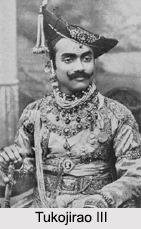 During British rule in India (which covers both the British East India Company rule and later the British Raj), the princely state of Dewas was ruled by different princes. This state had two branches namely, the "Junior Branch" and the "Senior Branch", which were established by Jivaji Rao (`Dada Saheb`) and Tukoji Rao (`Baba Saheb`). Both Dewas states were in the Malwa Agency of the Central India Agency and became a British protectorate on 12th of December, 1818. Given below are the rulers of Dewas.
During British rule in India (which covers both the British East India Company rule and later the British Raj), the princely state of Dewas was ruled by different princes. This state had two branches namely, the "Junior Branch" and the "Senior Branch", which were established by Jivaji Rao (`Dada Saheb`) and Tukoji Rao (`Baba Saheb`). Both Dewas states were in the Malwa Agency of the Central India Agency and became a British protectorate on 12th of December, 1818. Given below are the rulers of Dewas.
Rulers of the Junior Branch of Dewas
The Junior Branch of Dewas was ruled by "Rajas" as well as "Maharajas". These Rajas and Maharajas and their ruling period are mentioned below.
Rajas of the Junior Branch of Dewas
The names of the Rajas of the Junior Branch are Jivaji Rao Puar "Dada Sahib" (1728-1774), Sadashiv Rao I Puar (1774-1790), Rukmangad Rao Puar (1790 - 1817), Anand Rao Puar "Rao Sahib" (1817 - 1840), Haibat Rao Puar (1840 - 1864), Narayan Rao Puar "Dada Sahib" (1864 -1892) and Malhar Rao Puar "Bhava Sahib"(1892 - 1918).
Maharajas of the Junior Branch of Dewas
The names of the of the Maharajas of the Junior Branch are Sir Malhar Rao Puar "Bhava Sahib" (1918 - 1934), Sadashiv Rao II Puar "Khase Sahib"(1934 - 1943) and Yeshwant Rao Puar "Bhau Sahib"(1943 - 1947).
Rulers of the Senior Branch of Dewas
The Senior Branch of Dewas was also ruled by "Rajas" as well as "Maharajas". These Rajas and Maharajas and their ruling period are mentioned below.
Rajas of the Senior Branch of Dewas
The names of the Rajas of the Senior Branch are Tukoji Rao I Puar (1728 - 1754), Krishnaji Rao I Puar (1754 - 1789), Tukoji Rao II Puar (1789 - 1827), Rukmangad Tukoji Rao Puar (1827 - 1860), Krishnaji Rao II Puar (1860 - 1899) and Tukoji Rao III Puar "Kesho Rao" (1899 - 1918).
Maharajas of the Senior Branch of Dewas
Tukojirao III ruled Dewas from 1st of January, 1888 to 21st of December, 1937. Shahoji II, the son of Maharaja Tukoji Rao III Puar of Dewas Senior was the first Maharaja of Kolhapur to be adopted from the Puar dynasty. He served as the Maharaja of Dewas State from 1937 to 1947.
After India`s independence in 1947, the states of the Maharajas of Dewas were acceded to India and were integrated into Madhya Bharat, which became a state of India in 1950. In 1956, Madhya Bharat was merged with the state of Madhya Pradesh.



















